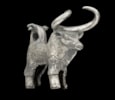Silver Zebu Bull
A rare hollow-cast silver bull with humped shoulders and large curved horns. Incised lines mark the eyes, nose, and thick shaggy coat on the midriff and dewlap. The underside is open. The rump supports a circular loop, topped with two engraved rivets, which may have supported a small offering dish (now missing). There are five stickers with inventory numbers on the custom black marble base, including one from Mathias Komor.
A ring-shaped standard with a deer and two bulls, found among the grave goods at Alacahöyük.
The Bronze Age Hattian people in central Anatolia, like many ancient civilisations, viewed the bull as a sacred animal. Many figures and vessels produced throughout this region in the 2nd and 1st millennia are in the form of zebu or other long-horned cattle. Long-horned bulls feature in the bronze standards and statues found in the 2nd millennium BC tombs at Alacahöyük in Alaca, modern-day Turkey. Cattle skulls and foot bones were also found arranged on the tops of the tombs. Possible reasons for their prominent placement include their association with the Storm God, their theorised role in pulling wagons, and their position as an elite status symbol. It therefore seems fitting that this silver zebu could have held a dish for use in ritual offerings. Sacred bulls were later adopted into the sun discs produced by the Hittites who took over this region from the Hattians in around 1700 BC. The bull was also associated with the ancient mother-goddess Cybele, and therefore with fertility and virility.
Exotic Art from Ancient and Primitive Civilizations: Collection of Jay C. Leff, Carnegie Institute, Pittsburgh, 1959-60
Exotic Art from Ancient and Primitive Civilizations: Collection of Jay C. Leff, exh. cat., Carnegie Institute, 1959-60, no. 6
Antiquities, Sotheby’s Parke Bernet, New York, 11 December 1976, lot 141
Antiquities and Islamic Art Including the Collection of the Late Lester Wolfe, New York, Sotheby’s, New York, 1-2 March 1984, lot 201
Previously in the Private Collection of Jay C. Leff (1925-2000), Uniontown, Pennsylvania, from at least 1959.
Private Collection of Mathias Komor (1909-1984), New York (sticker on base).
Sold at: Antiquities and Islamic Art Including the Collection of the Late Lester Wolfe, New York, Sotheby’s, New York, 1-2 March 1984, Lot 201.
ALR: S00228233, with IADAA Certificate, this item has been checked against the Interpol database.
Former president of the Fayette Bank and Trust Company of Uniontown, Pennsylvania, Jay Calvin Leff (1925-2000) amassed an extensive art collection between the 1950s and the 1970s. He collected a wide range of works, including African, Oceanic, Pre-Columbian Arts, and Antiquities. Over 800 objects from his collection, including the silver zebu, were exhibited at the Carnegie Institute, Pittsburgh, in 1959. Leff hoped this exhibition would encourage people to ‘charge brazenly into the art world’ and encourage respect for the cultures dismissed under the term ‘primitive’. Artworks from his collection were also famously exhibited at the Museum of Primitive Art, New York (1964), the American Federation of Arts, New York (1965), the American Museum of Natural History, New York (1965), and the Brooklyn Museum, New York (1966-67).
Mathias Komor (1909-1984) was one of the first art dealers in New York City to work with ancient and ethnographic art. He specialised in Old Master paintings and ancient Near Eastern, African and Egyptian art. He assembled his collection between the 1930s and his death in 1984. Komor ran a gallery at Madison Avenue and 71st Street after his arrival in the US in 1941, and served as a consultant to many other museums across the country. He kept extensive records and a strict inventory catalogue now in the Getty Research Centre archives. Many of the pieces which passed through his hands can be identified today through his collection stickers.










 Enquire
Enquire




